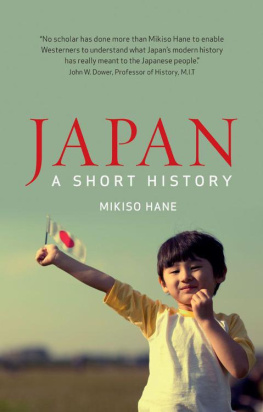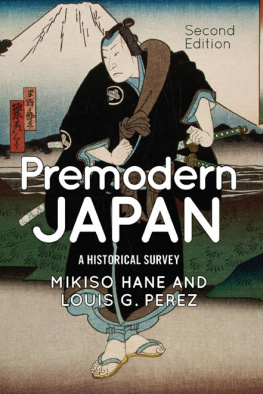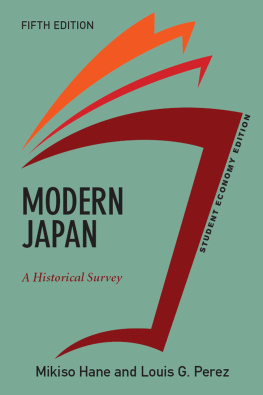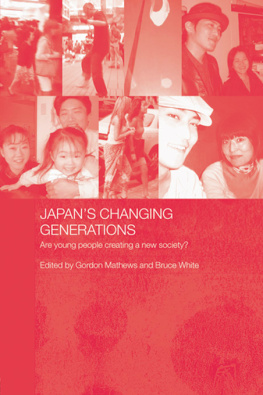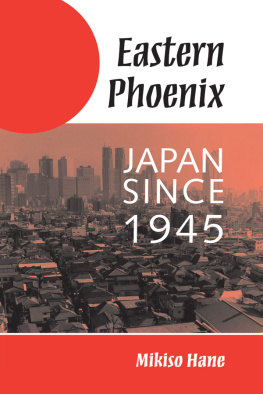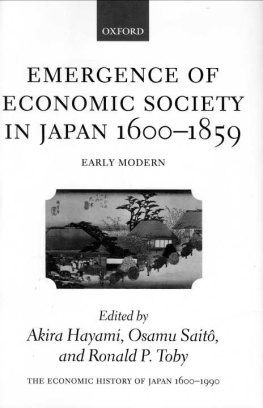ABOUT THE AUTHOR
Mikiso Hane (1922-2003) was Szold Distinguished Professor Emeritus of History at Knox College in Illinois. He enjoyed an illustrious career in the field of Japanese history, publishing fourteen books and numerous articles.
JAPAN
A SHORT HISTORY
MIKISO HANE

To Rose, Laurie and Jennifer
JAPAN: A SHORT HISTORY
This edition published in 2013
First published in Great Britain and the Commonwealth by
Oneworld Publications 2000
Copyright 2000 Mikiso Hane
The moral right of Mikiso Hane to be identified as the Author of this work has been asserted by him in accordance with the Copyright, Designs and Patents Act 1988
All rights reserved
Copyright under Berne Convention
A CIP record for this title is available
ISBN 978-1-78074-256-4
eISBN 978-1-78074-333-2
Printed and bound by Norhaven A/S, Denmark
Oneworld Publications
10 Bloomsbury Street
London WC1B 3SR
England
Stay up to date with the latest books, special offers, and exclusive content from Oneworld with our monthly newsletter
Sign up on our website www.oneworld-publications.com
Contents
Preface
I n this survey of Japanese history I have sought to present a general account of the developments in Japan from past to present, surveying not only political and economic matters but more especially, social, cultural, and intellectual issues. Japanese names have been presented in the traditional style, that is, surname first and given name second. The Hepburn system has been used to transcribe Japanese names and terms. In the pre-modern era it was the common practice to refer to people by their given names. For example artists and poets are referred to as Hiroshige, Utamaro, Bash and so on.
I wish to thank my friends and colleagues at Knox College for their kind support. I also wish to express my gratitude to members of Oneworld Publications for their valuable editorial assistance and advice. I wish to thank in particular Juliet Mabey for encouraging me to undertake this project, and Rebecca Clare and Alaine Low for examining the manuscript meticulously to ensure that what I have written is clear and accurate. Needless to say whatever errors and flaws still remain are due to my own carelessness.
Introduction
J apan ranked eighth in the world in population in 1998. Over 126.4 million people are crowded into an area about as large as the state of Montana. The islands that constitute the nation are mountainous, and only slightly over thirteen percent of the land is arable. Although the country is poor in natural resources, it is the worlds second most productive industrial nation. Until the nineteenth century it was an island nation virtually isolated from the rest of the world although historically it had close cultural ties with Korea and China. Its political, social, and economic life has been molded essentially by internal factors and developments.
For historical periodization the pre- and proto-historical periods have been classified into the early Jmon (c. 8000 B.C.E. or earlier to 250 B.C.E.) and Yayoi (c. 250 B.C.E. to 250 C.E.) periods. The former is named after the potteries with cord markings and the latter after the place where potteries belonging to this era were found. The next era is the Yamato period, c. 300710 CE., with the political center located in the area around Kyoto, then known as Yamato. This era is followed by the Nara period (710784) named after the capital city. For a decade the capital shifted to another city. This was followed by the establishment of the capital in Heian (present-day Kyoto), hence the Heian period (7941185). Then the Minamoto clan established its headquarters, the shogunate, in Kamakura (11851333). This was followed by the era of the Ashikaga shogunate from 1338 to 1573. After a quarter-century of ascendancy by two Chieftains (Oda Nobunaga and Toyotomi Hideyoshi) national unity and hegemony was established by the Tokuagawa clan whose regime lasted from 1600 to 1867. Since then the eras have been named after the reigning Emperors: Meiji (18681912), Taish (19121926), Shwa (19261989), and the current Heisei era (1989-).
Politically, after the migration of peoples from the continent and possibly South East Asia, the story is the struggle among various tribal and clan chieftains to establish hegemony over the islands. Eventually the clan that gained ascendancy established the imperial dynasty around the late fifth and early sixth century C.E. The actual wielders of power during the ascendancy of imperial rule to the twelfth century were the court aristocrats. The Emperor remained essentially a figurehead and was put on a pedestal. But throughout history no one dared to eliminate the Emperor system and outwardly treated it with honor. In the twelfth century the court aristocracy were challenged by the increasingly important warrior class and samurai rule was established. From the late twelfth to the nineteenth century different warrior clans retained political control and exercised power by providing the commanding general, the shogun. These leaders were challenged periodically by other military chieftains but from the early seventeenth century to the mid-nineteenth century firm political control was sustained by the Tokugawa shogunate. The imperial court was allowed to remain in Kyoto as the symbolic ruler of the land. Thus until the mid-nineteenth century when the country was opened to the West there were, in essence, two political forces, the military caste and the court aristocracy. In 1868 in theory imperial authority was restored but political power continued to be wielded by different political cliques, including the military, until Japans defeat in the Second World War.
The economy of Japan until the nineteenth century remained essentially agrarian. Rice culture was introduced to the islands around 100 B.C.E. and the peasants struggled to eke out a living, tilling the sparse land areas, growing rice in tiny paddies in the flat land and carving out terraces on the hillsides to grow other cereals and vegetables. Tea and silkworm cultivation also became an important source of income for the villagers. Eventually arts and crafts came to flourish with the introduction of the crafts from Korea and China from the fifth century on. The land worked by the peasants provided the ruling class with its material necessities. Thus the power struggle by the clan and tribal chieftains was a struggle to control the farm land and keep the peasants working it. Local commerce prevailed but in the thirteenth and fourteenth centuries trade with China was fostered. This stimulated greater commercial activities and greater external contacts, including the advent of Western traders and missionaries. With the country virtually sealed off by the Tokugawa shogunate in the seventeenth century foreign trade declined but domestic commerce flourished and numerous commercial centers emerged.
There was from the outset a hierarchy of the wielders of power and those subjected to serve them in various capacities. With the introduction of Confucian concepts in the fifth to sixth centuries the case for maintaining a hierarchical social order was strengthened. Hence the Confucian emphasis on preserving the hierarchical order between the superior and inferior persons and the maintenance of proper relationships to ensure social harmony (which meant compelling the inferior persons to behave in accordance with his or her station in the family and society) came to be staunchly embedded in Japanese mores. This social imperative was reinforced by the emergence of the samurai as the dominant force in the late twelfth century. They reinforced the sense of hierarchy by the edge of the sword. The Tokugawa shogunate instituted a legal class-order of samurai, peasants, artisans, and merchants (based on the Confucian hierarchy of scholars, peasants, artisans, and merchants). Outside this classification were the so-called unclean class, the outcastes. What this meant was the samurai caste at the top and the others below. Even after the end of Tokugawa hegemony and the advent of the modern Meiji era, class distinctions were retained with people in registries identified as

